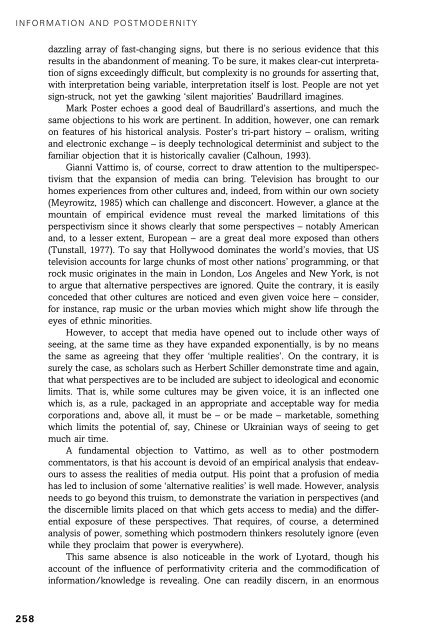Theories of the Information Society, Third Edition - Cryptome
Theories of the Information Society, Third Edition - Cryptome
Theories of the Information Society, Third Edition - Cryptome
You also want an ePaper? Increase the reach of your titles
YUMPU automatically turns print PDFs into web optimized ePapers that Google loves.
INFORMATION AND POSTMODERNITY<br />
dazzling array <strong>of</strong> fast-changing signs, but <strong>the</strong>re is no serious evidence that this<br />
results in <strong>the</strong> abandonment <strong>of</strong> meaning. To be sure, it makes clear-cut interpretation<br />
<strong>of</strong> signs exceedingly difficult, but complexity is no grounds for asserting that,<br />
with interpretation being variable, interpretation itself is lost. People are not yet<br />
sign-struck, not yet <strong>the</strong> gawking ‘silent majorities’ Baudrillard imagines.<br />
Mark Poster echoes a good deal <strong>of</strong> Baudrillard’s assertions, and much <strong>the</strong><br />
same objections to his work are pertinent. In addition, however, one can remark<br />
on features <strong>of</strong> his historical analysis. Poster’s tri-part history – oralism, writing<br />
and electronic exchange – is deeply technological determinist and subject to <strong>the</strong><br />
familiar objection that it is historically cavalier (Calhoun, 1993).<br />
Gianni Vattimo is, <strong>of</strong> course, correct to draw attention to <strong>the</strong> multiperspectivism<br />
that <strong>the</strong> expansion <strong>of</strong> media can bring. Television has brought to our<br />
homes experiences from o<strong>the</strong>r cultures and, indeed, from within our own society<br />
(Meyrowitz, 1985) which can challenge and disconcert. However, a glance at <strong>the</strong><br />
mountain <strong>of</strong> empirical evidence must reveal <strong>the</strong> marked limitations <strong>of</strong> this<br />
perspectivism since it shows clearly that some perspectives – notably American<br />
and, to a lesser extent, European – are a great deal more exposed than o<strong>the</strong>rs<br />
(Tunstall, 1977). To say that Hollywood dominates <strong>the</strong> world’s movies, that US<br />
television accounts for large chunks <strong>of</strong> most o<strong>the</strong>r nations’ programming, or that<br />
rock music originates in <strong>the</strong> main in London, Los Angeles and New York, is not<br />
to argue that alternative perspectives are ignored. Quite <strong>the</strong> contrary, it is easily<br />
conceded that o<strong>the</strong>r cultures are noticed and even given voice here – consider,<br />
for instance, rap music or <strong>the</strong> urban movies which might show life through <strong>the</strong><br />
eyes <strong>of</strong> ethnic minorities.<br />
However, to accept that media have opened out to include o<strong>the</strong>r ways <strong>of</strong><br />
seeing, at <strong>the</strong> same time as <strong>the</strong>y have expanded exponentially, is by no means<br />
<strong>the</strong> same as agreeing that <strong>the</strong>y <strong>of</strong>fer ‘multiple realities’. On <strong>the</strong> contrary, it is<br />
surely <strong>the</strong> case, as scholars such as Herbert Schiller demonstrate time and again,<br />
that what perspectives are to be included are subject to ideological and economic<br />
limits. That is, while some cultures may be given voice, it is an inflected one<br />
which is, as a rule, packaged in an appropriate and acceptable way for media<br />
corporations and, above all, it must be – or be made – marketable, something<br />
which limits <strong>the</strong> potential <strong>of</strong>, say, Chinese or Ukrainian ways <strong>of</strong> seeing to get<br />
much air time.<br />
A fundamental objection to Vattimo, as well as to o<strong>the</strong>r postmodern<br />
commentators, is that his account is devoid <strong>of</strong> an empirical analysis that endeavours<br />
to assess <strong>the</strong> realities <strong>of</strong> media output. His point that a pr<strong>of</strong>usion <strong>of</strong> media<br />
has led to inclusion <strong>of</strong> some ‘alternative realities’ is well made. However, analysis<br />
needs to go beyond this truism, to demonstrate <strong>the</strong> variation in perspectives (and<br />
<strong>the</strong> discernible limits placed on that which gets access to media) and <strong>the</strong> differential<br />
exposure <strong>of</strong> <strong>the</strong>se perspectives. That requires, <strong>of</strong> course, a determined<br />
analysis <strong>of</strong> power, something which postmodern thinkers resolutely ignore (even<br />
while <strong>the</strong>y proclaim that power is everywhere).<br />
This same absence is also noticeable in <strong>the</strong> work <strong>of</strong> Lyotard, though his<br />
account <strong>of</strong> <strong>the</strong> influence <strong>of</strong> performativity criteria and <strong>the</strong> commodification <strong>of</strong><br />
information/knowledge is revealing. One can readily discern, in an enormous<br />
258
















